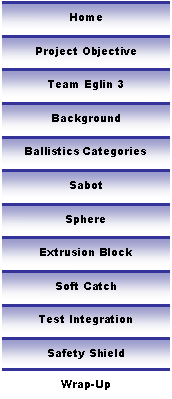
|
Wrap-up |
|
††††††††† After interfacing the newly designed components with the previously existing components, it has been verified that every new component fits into the design space with some slight modifications.† The only aspect of the test left is actual testing and optimization.† The testing will determine how well the objectives of each of the components were satisfied.† The optimization will improve both the safety of the experiment, and soft catching of the specimens.
†††††††† Test Schedule
The first test is firing the projectile to verify the hardened insert will be able to withstand the pressure from the specimen.† The second test is how well the recovered specimens resemble Dr. Garyís specimens.† The third test is observing how effective the sabot is at flying apart from the specimen.† After these components meet the sponsorís needs, then data can be obtained on the soft catch to determine if the specimens can be recovered unharmed with the medium configuration determined from prior testing.† More testing can be done to determine the size of the external ballistics space.† Currently, the test setup is under review by a range safety board at Eglin.† Once the Safety Board gives their approval, initial testing can begin.† A test date has not yet been officially set.
†††††††† Future Work
Future work can be geared toward studying the equations of motion above and below the critical velocity of the test specimen.† By utilizing the soft catch designed here, the necessary variables to determine penetration depth in a single medium can be obtained from testing.† With these variables, optimal soft catch devices can be designed for the specific experiment and specimen.† The current soft catch device can be used as a means to obtain the necessary data for improving it.
The Safety Shield is a device designed to protect the video equipment more than anything else.† After further testing once the new design space is defined, a new safety shield can be designed to reduce the size of the Plexiglas windows and to make all the cuts as tight of a fit as possible so nothing can escape the shield.
After testing, the sponsor can determine if any of the components do not perform properly. The components most likely to need improvement are the extrusion insert and the sabot.
If the sabot does not fly apart during free flight, more research may be needed to discover more ways of how sabots perform. The current sabots are cut in half to help them fly apart. Other possible methods to aid this process are different geometry or an opening mechanism such as a spring. If the projectile experiences inconsistencies in the velocity, then the sabot is not forming a gas seal in the gunís barrel. In this case, the back pocket of the sabot would need to be redesigned. The piece maybe need to be whole or the geometry of the sabot may need to be adjusted.
If the material of the extrusion device fails from the impact of the projectile, the piece may need a different heat treatment. The heat treatment may change the size of the extrusion device so dimensions should be carefully noted. Another option is to reproduce the insert out of a different material depending on what form of failure is experienced. If the extruded projectile is not satisfactory, the design will need to be revisited. Dr. Grayís report can be studied as well as the teamís approach to scaling Dr. Grayís archetype.
† |




|
Copyright 2006-2007 Famu-Fsu College of Engineering . All Rights Reserved |